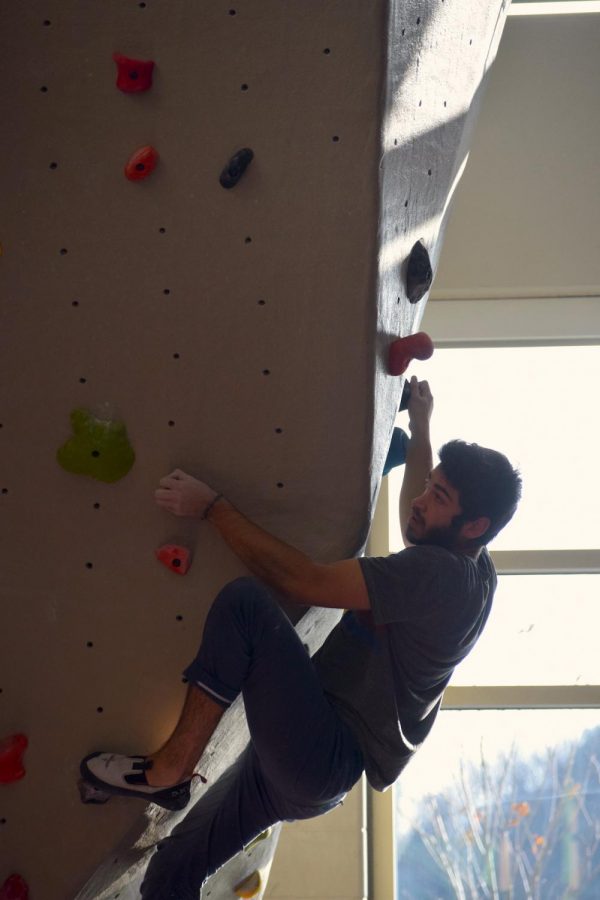Vigor in the Valley
Rock climbing poses physical and mental challenges to amateurs and experts alike
Photo by Eau Climbers
Austin Perkins scales a wall during a bouldering competition at UW-River Falls. Perkins coaches Eau Climbers, the indoor climbing club at UW-Eau Claire.
Rock climbing is more than reaching for some holds on a flat wall. It’s a puzzle to find the most efficient, quickest way to hoist oneself successfully to the summit. Climbing is mental: It’s about reaching farther, higher than one could imagine.
Karlee Nelsen, a fourth-year biology student, can recall her most memorable climb. She was five feet above her attachment point to the rock, nearing the spot where she’d clip her quickdraw to the next bolt hanger. Suddenly, she fell. By the time she reached the bottom of her rope, she’d fallen a total of about 10 feet.
Nelsen said falling was her biggest fear during climbing. Taking that fall helped her overcome that mental boundary and made her a better climber.
“It was because I did fail that it turned out okay, and kind of fun,” Nelsen said.
Nelsen ventured to the climbing wall in McPhee Strength and Performance Center when preparing for an interview with the Environmental Adventure Center and felt welcomed into the community. Today, she’s the president of Eau Climbers, an indoor climbing club at UW-Eau Claire.
The Eau Climbers are coached by Austin “Perky” Perkins, a third-year liberal studies student, with ten years of climbing experience under his harness.
Perkins calls the separate components of climbing “alpha” and “beta.” Alpha is what one does with your body. Beta is everything else, the cognitive aspect of the sport. A good climb, Perkins said, happens when alpha and beta connect to create a flow that makes the climber appear effortless.
Climbing requires painstaking patience. Some athletes spend years trying to “send”— that’s climber jargon for “complete” — a route.
Additionally, Perkins and Nelsen said a big push in climbing is to “leave no trace.” Originally, metal pitons were used for lead climbing, but they left scars on the rocks. New technology developed cams, which are spring-loaded devices that are less invasive.
Trad climbing is a technique in the category of lead climbing, where the rock climber attaches him or herself to a dynamic rope and periodically must create added security in the rock through the use of cams and nuts. Draws, or quickdraws — a type of clip — are attached to this protection, and the rope is secured in the quickdraws to allow a safe ascent for the climber.
Climbers avoid using chalk excessively, too, Nelsen said. Though it improves grip, it gives away the best route to the top, therefore ruining the beta aspect of the climb.
During a quiet point in their shift at the new bouldering wall in the Hilltop Recreation Center, I spoke with Nelsen and Perkins about their passion for climbing as a sport and as a lifestyle.
Me: How did you start climbing?
Perkins: “The summer after my freshman year in high school, I was 15. I took a week-long climbing camp. I signed up for two weeks of it; after the first week, I was like ‘I need to do this again.’ I immediately just fell in love. I caught the climbing bug hardcore. I went from being a non-athletic nerd to an athletic nerd throughout high school. It became one of the biggest things that defines me.”
What’s the best way to begin climbing?
Nelsen: “Come to the wall and start trying it. There’s no way to learn without actually doing it. You can watch people all day and it’s really easy to see what they’re going to be doing, but to actually know how to climb, you have to be there, trying it. And it’s definitely a lot easier to climb with someone who’s climbed before.”
Perkins: “The climbing community is really great because there is this sort of mentorship thing. You’ll usually find someone who knows more than you who wants to teach you. This is what I love about climbing: Climbers want more climbers.”
Nelsen: “I definitely believe our climbing community is very welcoming. No matter who comes to our climbing wall here, or in McPhee, we’re really welcoming, and we’ll show them the ropes — literally and figuratively.”
How can you prepare your body for climbing without a wall or rock to practice on?
Perkins: “Really the best thing to do is a calisthenic workout. Basically, the idea is that you’re using your own body weight. Pullups, pushups; there’s actually a calisthenic park in Owen Park with instructional plaques.”
What’s on your climbing bucket list?
Perkins: “For a bucket list, I don’t really have ambitions like that, climbing-wise. My goal in climbing is to climb as long as I live. I am inspired by seeing videos of people climbing in their 90s, and I want to be that guy.”
Nelsen: “I really like Red River Gorge. It’s a whole park run by and for climbers.”
Do you have anything to add?
Nelsen: “Don’t let your fear of heights hold you back. The worst thing that happens is your partner catches you.”
Perkins: “Don’t think that any sort of body type or body restrictions will hold you back. That’s the great thing about climbing, it’s accessible to everybody and fun, no matter what you do. You don’t have to be amazing at it to enjoy it.”
Additionally, the university has two indoor sites available for use.
The rock wall in McPhee is open from 6:30 to 10:30 p.m. Monday through Wednesday and from 7:30 to 10:30 p.m. on Thursday. Fees start at $5 a day for students.
The new bouldering wall in Hilltop is open from noon to 11 p.m. all days of the week except Friday and Saturday, when it is open noon to midnight. It is free for students with ID.
Perkins, Nelsen and the rest of the Eau Climbers meet from 7 to 9 p.m. at the wall in McPhee on Mondays and at the bouldering wall in Hilltop on Thursdays.
Neupert can be reached at neupercm7411@uwec.edu.

Neupert is a fourth-year journalism student at UW-Eau Claire. She is the executive producer of Engage Eau Claire on Blugold Radio Sunday. In her spare time, Neupert's working on becoming a crossword puzzle expert.


